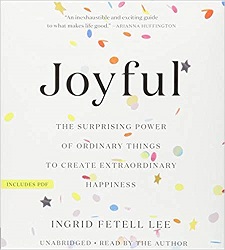
 Joyful
JoyfulThe Surprising Power of Ordinary Things to Create Extraordinary Happiness
Reviewed April 3, 2019.
Hachette Audio, 2018. 9.5 hours on 8 CDs.
Starred Review
2019 Sonderbooks Standout:
#4 General Nonfiction
I listened to this in audio form, then put the print book on hold so I could pull out the main points for this review. I’m finding I want to read it again.
I’ve read other books on finding joy, most notably Champagne for the Soul, by Mike Mason. This one is very different, not looking at joy from a spiritual or emotional perspective, but from a design perspective. It turns out that certain objects and certain sights can actually spark joy. In this book the author categorizes the types of things that bring joy and tells about visiting places that embody this. It’s a fascinating book and will give you plenty of ideas to try in order to bring joy into your everyday life.
This is a perspective on joy that I never thought of before, and I love it. In the introduction, she talks about finding joy in physical things.
I noticed many moments when people seemed to find real joy in the material world. Gazing at a favorite painting in an art museum or making a sandcastle at the beach, people smiled and laughed, lost in the moment. They smiled, too, at the peachy light of the sunset and at the shaggy dog with the yellow galoshes. And not only did people seem to find joy in the world around them, but many also put a lot of effort into making their immediate environment more delightful. They tended rose gardens, put candles on birthday cakes, and hung lights for the holidays. Why would people do these things if they had no real effect on their happiness?
A body of research is emerging that demonstrates a clear link between our surroundings and our mental health. For example, studies show that people with sunny workspaces sleep better and laugh more than their peers in dimly lit offices, and that flowers improve not only people’s moods but their memory as well. As I delved deeper into these findings, joy started to become less amorphous and abstract to me and more tangible and real. It no longer seemed difficult to attain, the result of years of introspection or disciplined practice. Instead, I began to see the world as a reservoir of positivity that I could turn to at any time. I found that certain places have a kind of buoyancy – a bright corner café, a local yarn shop, a block of brownstones whose window boxes overflow with blooms – and I started changing my routines to visit them more often. On bad days, rather than feeling overwhelmed and helpless, I discovered small things that could reliably lift my spirits. I started incorporating what I learned into my home and began to feel a sense of excitement as I put my key into the lock each evening. Over time, it became clear to me that the conventional wisdom about joy was wrong.
Joy isn’t hard to find at all. In fact, it’s all around us.
The liberating awareness of this simple truth changed my life. As I started to share it with others, I found that many people felt the impulse to seek joy in their surroundings but had been made to feel as if their efforts were misguided. One woman told me that buying cut flowers lifted her spirits for days, but she felt like it was a frivolous indulgence, so she only did it on special occasions. It had never occurred to her that for the price of one of her weekly therapy sessions, she could buy a bunch of flowers every other week for a year. Another described how she had walked into her living room after repainting it and felt an “ahhh” feeling – a sense of relief and lightness that made her wonder why she had waited so long to do it. I realized that we all have an inclination to seek joy in our surroundings, yet we have been taught to ignore it. What might happen if we were to reawaken this instinct for finding joy?
As she studied joy and sought out the aesthetics of joy, she was able to make connections and put them into ten categories.
In all, I identified ten aesthetics of joy, each of which reveals a distinct connection between the feeling of joy and the tangible qualities of the world around us:
Energy: vibrant color and light
Abundance: lushness, multiplicity, and variety
Freedom: nature, wildness, and open space
Harmony: balance, symmetry, and flow
Play: circles, spheres, and bubbly forms
Surprise: contrast and whimsy
Transcendence: elevation and lightness
Magic: invisible forces and illusions
Celebration: synchrony, sparkle, and bursting shapes
Renewal: blossoming, expansion, and curves
The ten chapters of the book delve into these ten aesthetics in lovely rambling detail. They give ideas for how you can build them into your own life, but in many cases tell about someone who has indulged in this particular aesthetic in a big way – with striking results.
The final chapter in the print book wasn’t included in the audiobook (unless there were extra files I didn’t notice) – a Joy Toolkit with worksheets to fill out to help you fill your own life with joy. But you can download those worksheets from the website.
